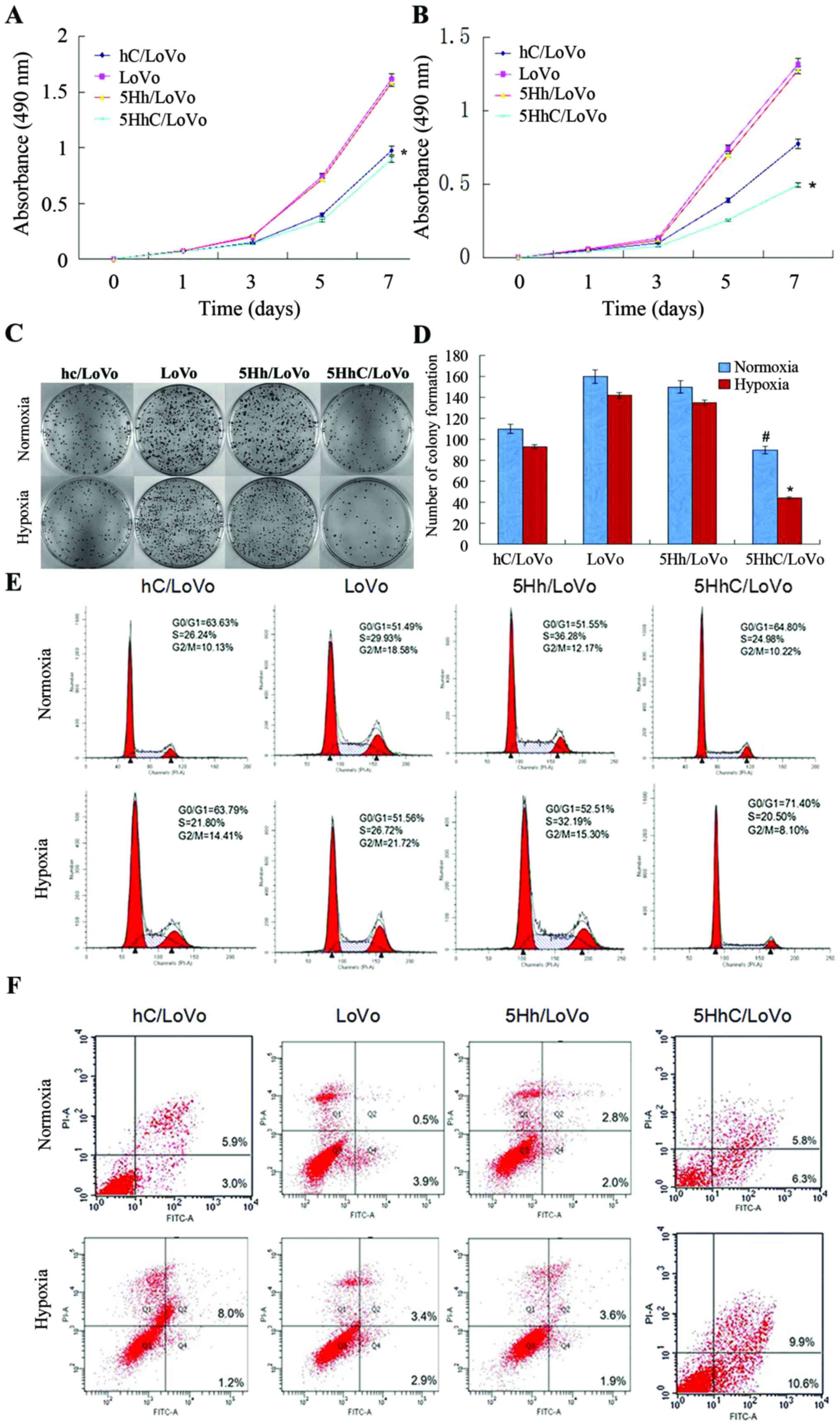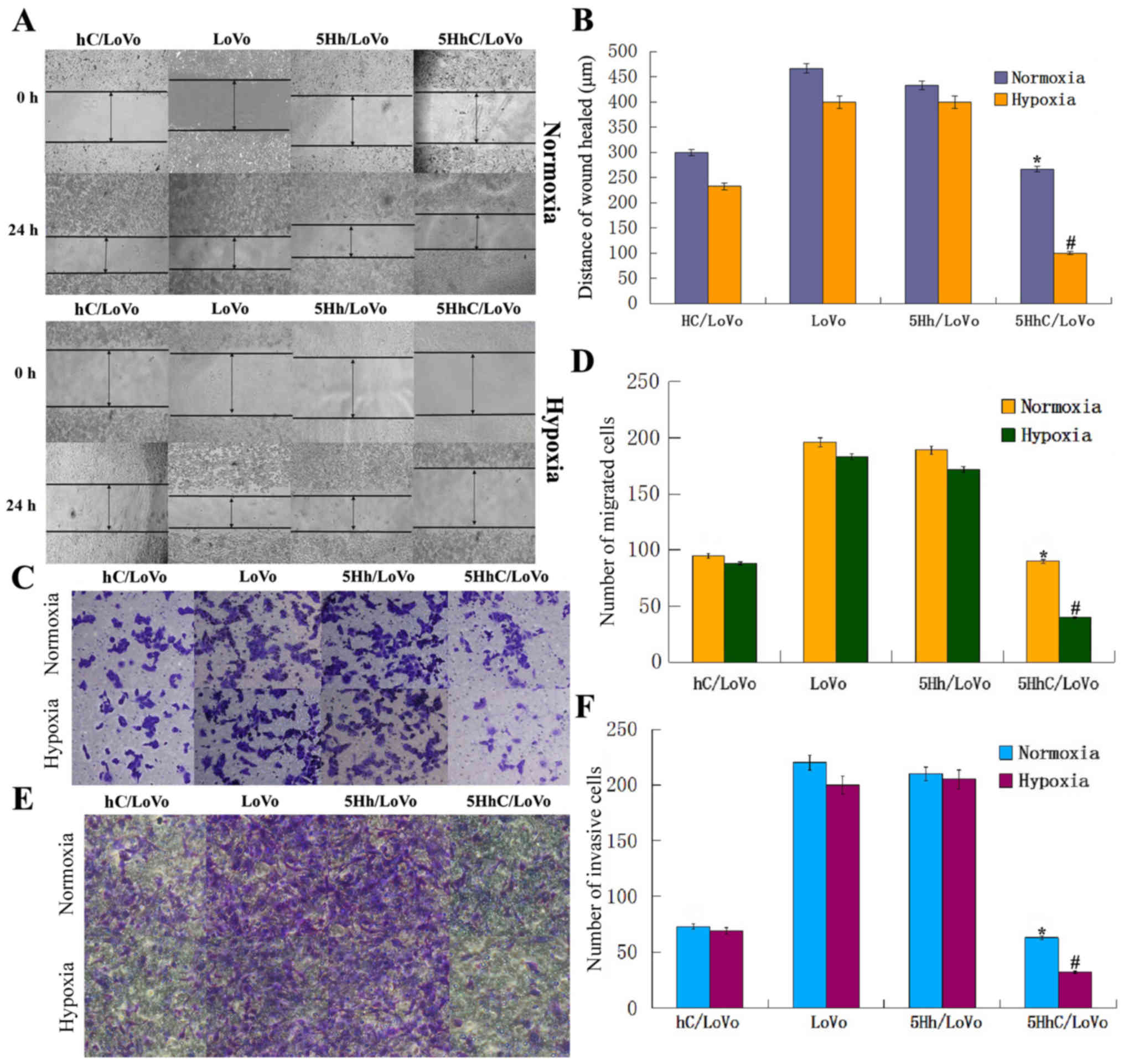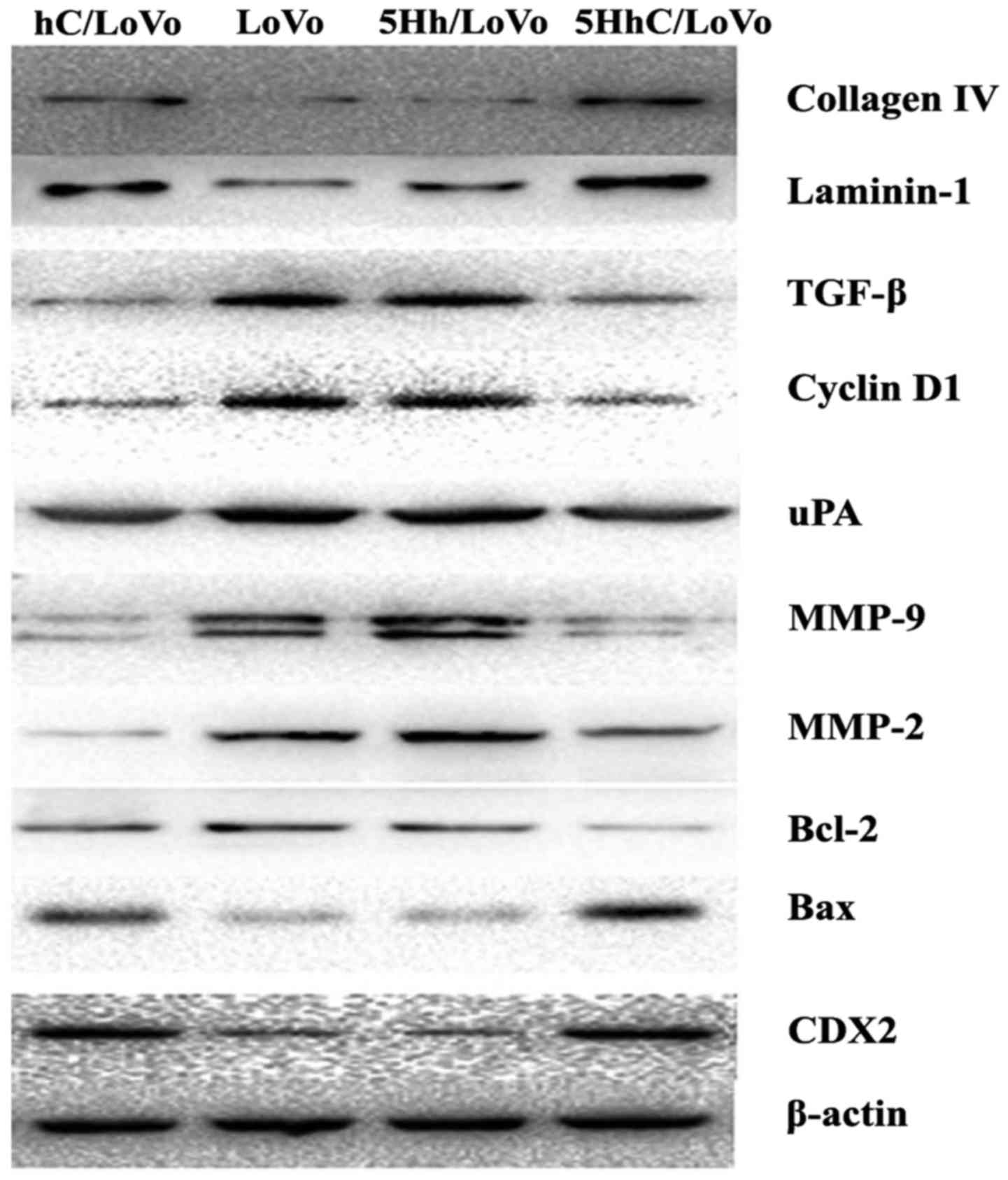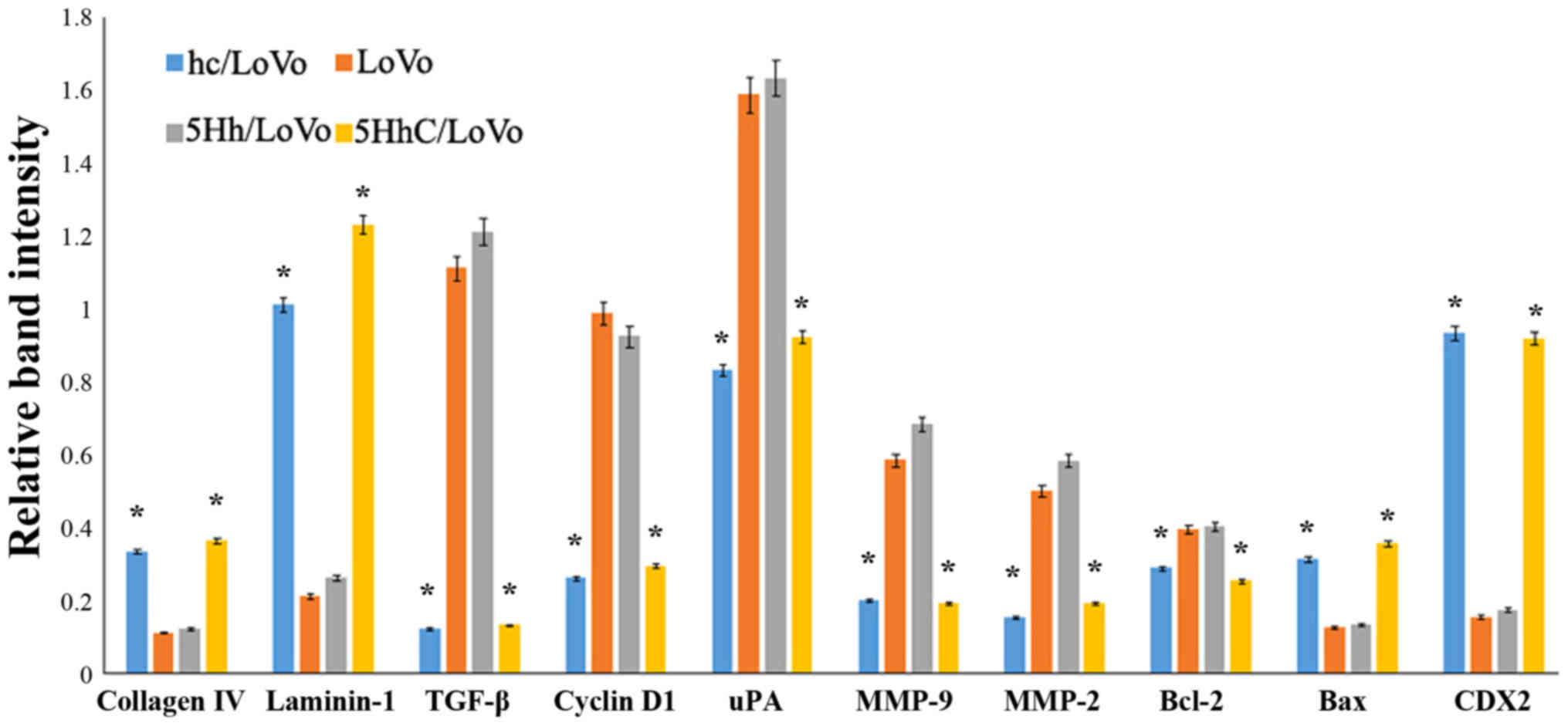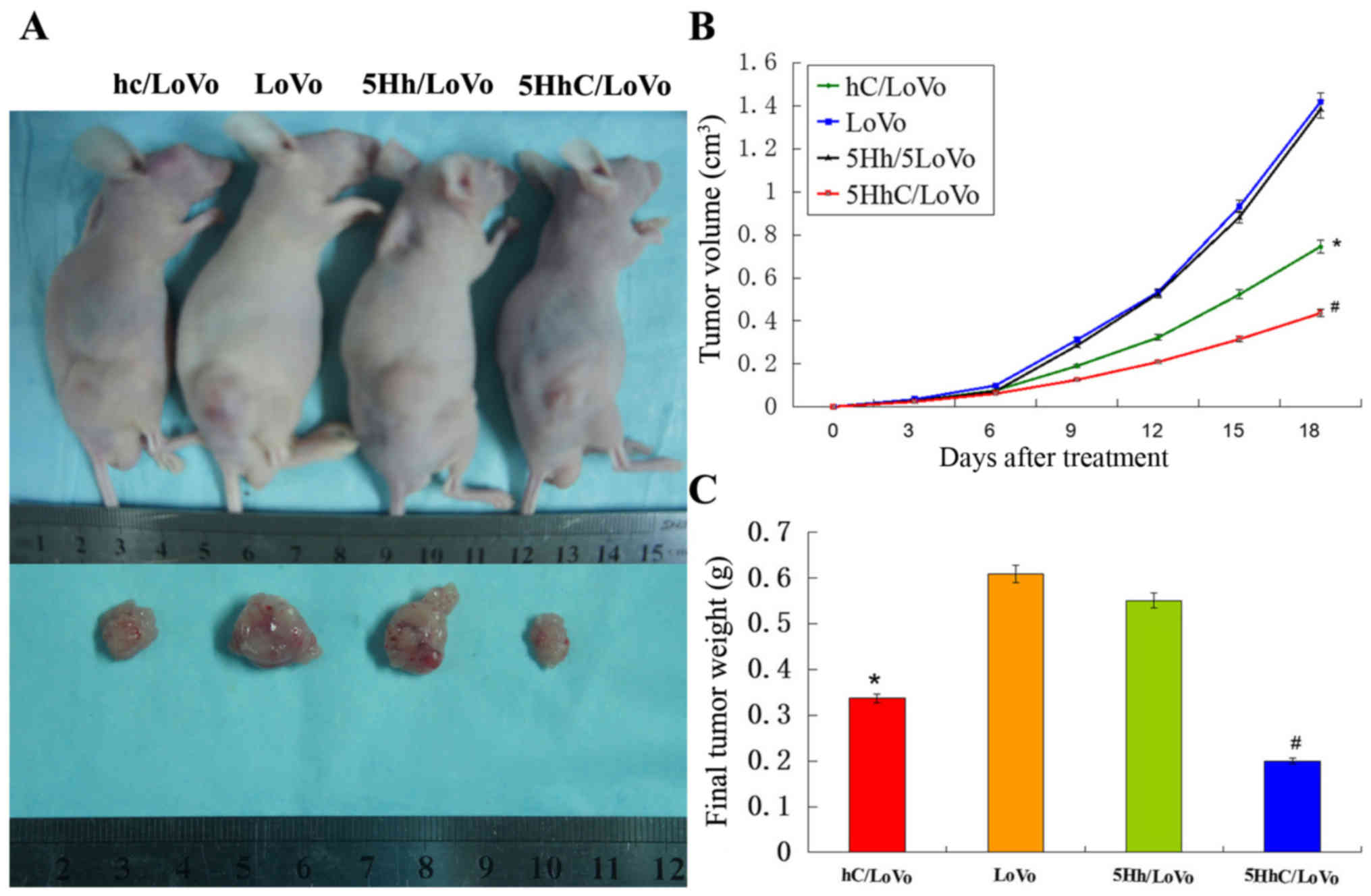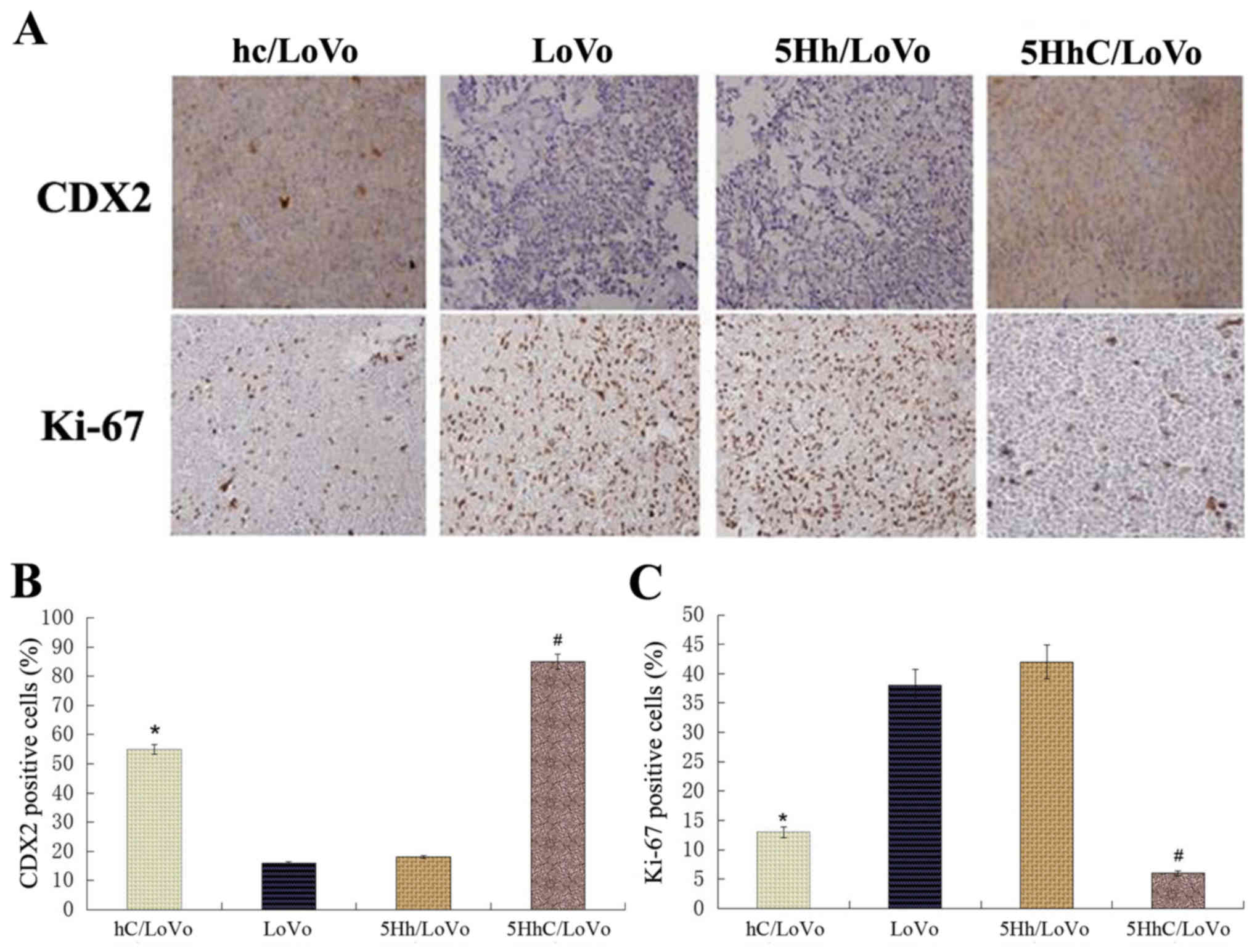|
1
|
Siegel RL, Miller KD and Jemal A: Cancer
statistics, 2016. CA Cancer J Clin. 66:7–30. 2016. View Article : Google Scholar : PubMed/NCBI
|
|
2
|
Shayakhmetov DM, Di Paolo NC and Mossman
KL: Recognition of virus infection and innate host responses to
viral gene therapy vectors. Mol Ther. 18:1422–1429. 2010.
View Article : Google Scholar : PubMed/NCBI
|
|
3
|
Chen EQ, Song XQ, Wang YL, Zhou TY, Bai L,
Liu L, Liu C, Cheng X and Tang H: Construction of a highly-active,
liver-specific transcriptional regulatory element through
combination of the albumin promoter and α-fetoprotein enhancer.
Plasmid. 65:125–131. 2011. View Article : Google Scholar
|
|
4
|
Dong K, Wang R, Wang X, Lin F, Shen JJ,
Gao P and Zhang HZ: Tumor-specific RNAi targeting eIF4E suppresses
tumor growth, induces apoptosis and enhances cisplatin cytotoxicity
in human breast carcinoma cells. Breast Cancer Res Treat.
113:443–456. 2009. View Article : Google Scholar
|
|
5
|
Akhavan-Niaki H and Samadani AA: Molecular
insight in gastric cancer induction: An overview of cancer stemness
genes. Cell Biochem Biophys. 68:463–473. 2014. View Article : Google Scholar
|
|
6
|
Natoli M, Christensen J, El-Gebali S,
Felsani A and Anderle P: The role of CDX2 in Caco-2 cell
differentiation. Eur J Pharm Biopharm. 85:20–25. 2013. View Article : Google Scholar : PubMed/NCBI
|
|
7
|
Lin ME, Huang D, Deng BH, Lv YS, Rong L
and Yao YS: Expression and functional role of Cdx2 in intestinal
metaplasia of cystitis glandularis. J Urol. 190:1083–1089. 2013.
View Article : Google Scholar : PubMed/NCBI
|
|
8
|
Gross I, Duluc I, Benameur T, Calon A,
Martin E, Brabletz T, Kedinger M, Domon-Dell C and Freund JN: The
intestine-specific homeobox gene Cdx2 decreases mobility and
antagonizes dissemination of colon cancer cells. Oncogene.
27:107–115. 2008. View Article : Google Scholar
|
|
9
|
Aoki K, Tamai Y, Horiike S, Oshima M and
Taketo MM: Colonic polyposis caused by mTOR-mediated chromosomal
instability in Apc+/Delta716
Cdx2+/− compound mutant mice. Nat Genet.
35:323–330. 2003. View
Article : Google Scholar : PubMed/NCBI
|
|
10
|
Chawengsaksophak K, James R, Hammond VE,
Köntgen F and Beck F: Homeosis and intestinal tumours in Cdx2
mutant mice. Nature. 386:84–87. 1997. View
Article : Google Scholar : PubMed/NCBI
|
|
11
|
Olsen AK, Coskun M, Bzorek M, Kristensen
MH, Danielsen ET, Jørgensen S, Olsen J, Engel U, Holck S and
Troelsen JT: Regulation of APC and AXIN2 expression by intestinal
tumor suppressor CDX2 in colon cancer cells. Carcinogenesis.
34:1361–1369. 2013. View Article : Google Scholar : PubMed/NCBI
|
|
12
|
Hong KD, Lee D, Lee Y, Lee SI and Moon HY:
Reduced CDX2 expression predicts poor overall survival in patients
with colorectal cancer. Am Surg. 79:353–360. 2013.PubMed/NCBI
|
|
13
|
Zheng JB, Sun XJ, Qi J, Li SS, Wang W, Ren
HL, Tian Y, Lu SY and Du JK: Effects of homeodomain protein CDX2
expression on the proliferation and migration of lovo colon cancer
cells. Pathol Oncol Res. 17:743–751. 2011. View Article : Google Scholar : PubMed/NCBI
|
|
14
|
Wang W, Jin B, Li W, Xu CX, Cui FA, Liu B,
Yan YF, Liu XX and Wang XL: Targeted antitumor effect induced by
hTERT promoter mediated ODC antisense adenovirus. Mol Biol Rep.
37:3239–3247. 2010. View Article : Google Scholar
|
|
15
|
Bougel S, Renaud S, Braunschweig R,
Loukinov D, Morse HC III, Bosman FT, Lobanenkov V and Benhattar J:
PAX5 activates the transcription of the human telomerase reverse
transcriptase gene in B cells. J Pathol. 220:87–96. 2010.
View Article : Google Scholar
|
|
16
|
Zhang P, Tan J, Yang DB, Luo ZC, Luo S,
Chen P, Sun P, Zhou Y, Chen XC, Wei YQ, et al: Gene therapy using
the human telomerase catalytic subunit gene promoter enables
targeting of the therapeutic effects of vesicular stomatitis virus
matrix protein against human lung adenocarcinoma. Exp Ther Med.
4:859–864. 2012.PubMed/NCBI
|
|
17
|
Hioki M, Kagawa S and Fujiwara T, Sakai R,
Kojima T, Watanabe Y, Hashimoto Y, Uno F, Tanaka N and Fujiwara T:
Combination of oncolytic adenovirotherapy and Bax gene therapy in
human cancer xenografted models. Potential merits and hurdles for
combination therapy. Int J Cancer. 122:2628–2633. 2008. View Article : Google Scholar : PubMed/NCBI
|
|
18
|
Gout S and Huot J: Role of cancer
microenvironment in metastasis: Focus on colon cancer. Cancer
Microenviron. 1:69–83. 2008. View Article : Google Scholar
|
|
19
|
Jubb AM, Buffa FM and Harris AL:
Assessment of tumour hypoxia for prediction of response to therapy
and cancer prognosis. J Cell Mol Med. 14:18–29. 2010. View Article : Google Scholar
|
|
20
|
Law AY, Ching LY, Lai KP and Wong CK:
Identification and characterization of the hypoxia-responsive
element in human stanniocalcin-1 gene. Mol Cell Endocrinol.
314:118–127. 2010. View Article : Google Scholar
|
|
21
|
Zhang J, Shi Q, Chen X, Yang P, Qi C,
Zhang J, Lu H, Liu J, Jiao Q, Zhao L, et al: Hypoxia-regulated
neurotrophin-3 expression by multicopy hypoxia response elements
reduces apoptosis in PC12 cells. Int J Mol Med. 30:1173–1179.
2012.PubMed/NCBI
|
|
22
|
Hu J, Stiehl DP, Setzer C, Wichmann D,
Shinde DA, Rehrauer H, Hradecky P, Gassmann M and Gorr TA:
Interaction of HIF and USF signaling pathways in human genes
flanked by hypoxia-response elements and E-box palindromes. Mol
Cancer Res. 9:1520–1536. 2011. View Article : Google Scholar : PubMed/NCBI
|
|
23
|
Zheng J, Sun X, Wang W and Lu S:
Hypoxia-inducible factor-1α modulates the down-regulation of the
homeodomain protein CDX2 in colorectal cancer. Oncol Rep.
24:97–104. 2010.PubMed/NCBI
|
|
24
|
Shibata T, Giaccia AJ and Brown JM:
Development of a hypoxia-responsive vector for tumor-specific gene
therapy. Gene Ther. 7:493–498. 2000. View Article : Google Scholar : PubMed/NCBI
|
|
25
|
Zhou PH, Zheng JB, Wei GB, Wang XL, Wang
W, Chen NZ, Yu JH, Yao JF, Wang H, Lu SY, et al:
Lentivirus-mediated RASSF1A expression suppresses aggressive
phenotypes of gastric cancer cells in vitro and in vivo. Gene Ther.
22:793–801. 2015. View Article : Google Scholar : PubMed/NCBI
|
|
26
|
He S, Sun XJ, Zheng JB, Qi J, Chen NZ,
Wang W, Wei GB, Liu D, Yu JH, Lu SY, et al: Recombinant lentivirus
with enhanced expression of caudal-related homeobox protein 2
inhibits human colorectal cancer cell proliferation in vitro. Mol
Med Rep. 12:1838–1844. 2015.PubMed/NCBI
|
|
27
|
Ji J and Zheng PS: Expression of Sox2 in
human cervical carcinogenesis. Hum Pathol. 41:1438–1447. 2010.
View Article : Google Scholar : PubMed/NCBI
|
|
28
|
Li X, Wang K, Ren Y, Zhang L, Tang XJ,
Zhang HM, Zhao CQ, Liu PJ, Zhang JM and He JJ: MAPK signaling
mediates sino-menine hydrochloride-induced human breast cancer cell
death via both reactive oxygen species-dependent and -independent
pathways: An in vitro and in vivo study. Cell Death Dis.
5:e13562014. View Article : Google Scholar
|
|
29
|
Witek ME, Snook AE, Lin JE, Blomain ES,
Xiang B, Magee MS and Waldman SA: A novel CDX2 isoform regulates
alternative splicing. PLoS One. 9:e1042932014. View Article : Google Scholar : PubMed/NCBI
|
|
30
|
Bae JM, Lee TH, Cho NY, Kim TY and Kang
GH: Loss of CDX2 expression is associated with poor prognosis in
colorectal cancer patients. World J Gastroenterol. 21:1457–1467.
2015. View Article : Google Scholar : PubMed/NCBI
|
|
31
|
Olsen J, Eiholm S, Kirkeby LT, Espersen
ML, Jess P, Gögenür I, Olsen J and Troelsen JT: CDX2 downregulation
is associated with poor differentiation and MMR deficiency in colon
cancer. Exp Mol Pathol. 100:59–66. 2016. View Article : Google Scholar
|
|
32
|
Dawson H, Koelzer VH, Lukesch AC, Mallaev
M, Inderbitzin D, Lugli A and Zlobec I: Loss of Cdx2 expression in
primary tumors and lymph node metastases is specific for mismatch
repair-deficiency in colorectal cancer. Front Oncol. 3:2652013.
View Article : Google Scholar : PubMed/NCBI
|
|
33
|
Olsen J, Espersen ML, Jess P, Kirkeby LT
and Troelsen JT: The clinical perspectives of CDX2 expression in
colorectal cancer: A qualitative systematic review. Surg Oncol.
23:167–176. 2014. View Article : Google Scholar : PubMed/NCBI
|
|
34
|
Zheng JB, Qiao LN, Sun XJ, Qi J, Ren HL,
Wei GB, Zhou PH, Yao JF, Zhang L and Jia PB: Overexpression of
caudal-related homeobox transcription factor 2 inhibits the growth
of transplanted colorectal tumors in nude mice. Mol Med Rep.
12:3409–3415. 2015.PubMed/NCBI
|
|
35
|
Xu Y, Hou J, Liu Z, Yu H, Sun W, Xiong J,
Liao Z, Zhou F, Xie C and Zhou Y: Gene therapy with tumor-specific
promoter mediated suicide gene plus IL-12 gene enhanced tumor
inhibition and prolonged host survival in a murine model of Lewis
lung carcinoma. J Transl Med. 9:392011. View Article : Google Scholar : PubMed/NCBI
|
|
36
|
Zhang Y, Toh L, Lau P and Wang X: Human
telomerase reverse transcriptase (hTERT) is a novel target of the
Wnt/β-catenin pathway in human cancer. J Biol Chem.
287:32494–32511. 2012. View Article : Google Scholar : PubMed/NCBI
|
|
37
|
Shepelev MV, Kopantzev EP, Vinogradova TV,
Sverdlov ED and Korobko IV: hTERT and BIRC5 gene promoters for
cancer gene therapy: A comparative study. Oncol Lett. 12:1204–1210.
2016.PubMed/NCBI
|
|
38
|
Paolicchi E, Gemignani F, Krstic-Demonacos
M, Dedhar S, Mutti L and Landi S: Targeting hypoxic response for
cancer therapy. Oncotarget. 7:13464–13478. 2016.PubMed/NCBI
|
|
39
|
Zhang H, Liang C, Hou X, Wang L and Zhang
D: Study of the combined treatment of lung cancer using gene-loaded
immunomagnetic albumin nanospheres in vitro and in vivo. Int J
Nanomed. 11:1039–1050. 2016. View Article : Google Scholar
|
|
40
|
Harvey TJ, Hennig IM, Shnyder SD, Cooper
PA, Ingram N, Hall GD, Selby PJ and Chester JD: Adenovirus-mediated
hypoxia-targeted gene therapy using HSV thymidine kinase and
bacterial nitroreductase prodrug-activating genes in vitro and in
vivo. Cancer Gene Ther. 18:773–784. 2011. View Article : Google Scholar : PubMed/NCBI
|
|
41
|
Wang W, Sun X, Lu L, Zheng JB, Tian Y and
Wang W: Cytotoxicity of lymphocytes activated by superantigen
toxic-shock-syndrome toxin-1 against colorectal cancer LoVo cells.
Mol Cell Biochem. 376:1–9. 2013. View Article : Google Scholar : PubMed/NCBI
|
|
42
|
Brabletz T, Spaderna S, Kolb J, Hlubek F,
Faller G, Bruns CJ, Jung A, Nentwich J, Duluc I, Domon-Dell C, et
al: Down-regulation of the homeodomain factor Cdx2 in colorectal
cancer by collagen type I: An active role for the tumor environment
in malignant tumor progression. Cancer Res. 64:6973–6977. 2004.
View Article : Google Scholar : PubMed/NCBI
|
|
43
|
Turck N, Gross I, Gendry P, Stutzmann J,
Freund JN, Kedinger M, Simon-Assmann P and Launay JF: Laminin
isoforms: Biological roles and effects on the intracellular
distribution of nuclear proteins in intestinal epithelial cells.
Exp Cell Res. 303:494–503. 2005. View Article : Google Scholar : PubMed/NCBI
|
|
44
|
Yusra, Semba S and Yokozaki H: Biological
significance of tumor budding at the invasive front of human
colorectal carcinoma cells. Int J Oncol. 41:201–210.
2012.PubMed/NCBI
|
|
45
|
Wei W, Li L, Wang X, Yan L, Cao W, Zhan Z,
Zhang X, Yu H, Xie Y and Xiao Q: Overexpression of caudal type
homeobox transcription factor 2 inhibits the growth of the MGC-803
human gastric cancer cell line in vivo. Mol Med Rep. 12:905–912.
2015.PubMed/NCBI
|
|
46
|
Seno H, Oshima M, Taniguchi MA, Usami K,
Ishikawa TO, Chiba T and Taketo MM: CDX2 expression in the stomach
with intestinal metaplasia and intestinal-type cancer: Prognostic
implications. Int J Oncol. 21:769–774. 2002.PubMed/NCBI
|




